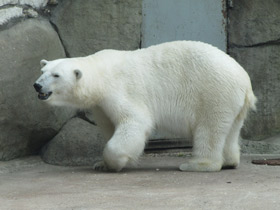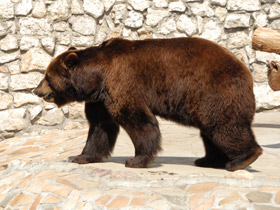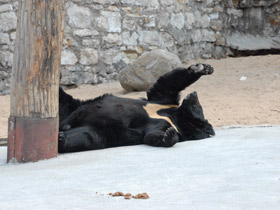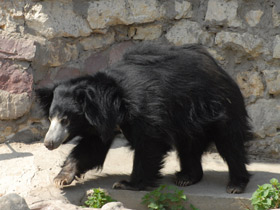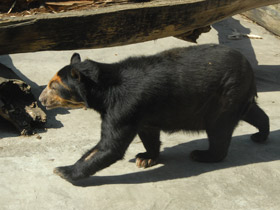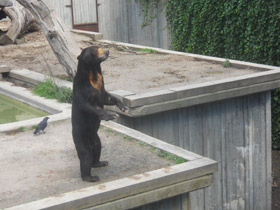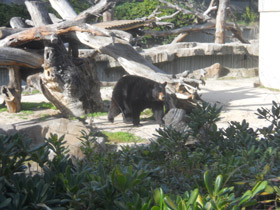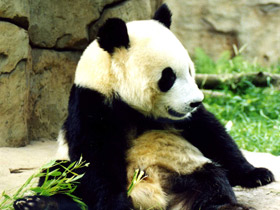The family Ursidae (Bears)
Bears are carnivoran mammals of the family Ursidae (/ˈɜːrsɪdiː, -daɪ/). They are classified as caniforms, or doglike carnivorans. Although only eight species of bears are extant, they are widespread, appearing in a wide variety of habitats throughout most of the Northern Hemisphere and partially in the Southern Hemisphere. Bears are found on the continents of North America, South America, and Eurasia. Common characteristics of modern bears include large bodies with stocky legs, long snouts, small rounded ears, shaggy hair, plantigrade paws with five nonretractile claws, and short tails.
While the polar bear is mostly carnivorous, and the giant panda is mostly herbivorous, the remaining six species are omnivorous with varying diets. With the exception of courting individuals and mothers with their young, bears are typically solitary animals. They may be diurnal or nocturnal and have an excellent sense of smell. Despite their heavy build and awkward gait, they are adept runners, climbers, and swimmers. Bears use shelters, such as caves and logs, as their dens; most species occupy their dens during the winter for a long period of hibernation, up to 100 days.
Bears have been hunted since prehistoric times for their meat and fur; they have also been used for bear-baiting and other forms of entertainment, such as being made to dance. With their powerful physical presence, they play a prominent role in the arts, mythology, and other cultural aspects of various human societies. In modern times, bears have come under pressure through encroachment on their habitats and illegal trade in bear parts, including the Asian bile bear market. The IUCN lists six bear species as vulnerable or endangered, and even least concern species, such as the brown bear, are at risk of extirpation in certain countries. The poaching and international trade of these most threatened populations are prohibited, but still ongoing.
Etymology
The English word "bear" comes from Old English bera and belongs to a family of names for the bear in Germanic languages, such as Swedish björn, also used as a first name. This form is conventionally said to be related to a Proto-Indo-European word for "brown", so that "bear" would mean "the brown one". However, Ringe notes that while this etymology is semantically plausible, a word meaning "brown" of this form cannot be found in Proto-Indo-European. He suggests instead that "bear" is from the Proto-Indo-European word *ǵʰwḗr- ~ *ǵʰwér "wild animal". This terminology for the animal originated as a taboo avoidance term: proto-Germanic tribes replaced their original word for bear—arkto—with this euphemistic expression out of fear that speaking the animal's true name might cause it to appear. According to author Ralph Keyes, this is the oldest known euphemism.
Bear taxon names such as Arctoidea and Helarctos come from the ancient Greek ἄρκτος (arktos), meaning bear, as do the names "arctic" and "antarctic", via the name of the constellation Ursa Major, the "Great Bear", prominent in the northern sky.
Bear taxon names such as Ursidae and Ursus come from Latin Ursus/Ursa, he-bear/she-bear. The female first name "Ursula", originally derived from a Christian saint's name, means "little she-bear" (diminutive of Latin ursa). In Switzerland, the male first name "Urs" is especially popular, while the name of the canton and city of Bern is by legend derived from Bär, German for bear. The Germanic name Bernard (including Bernhardt and similar forms) means "bear-brave", "bear-hardy", or "bold bear". The Old English name Beowulf is a kenning, "bee-wolf", for bear, in turn meaning a brave warrior.
Taxonomy
The family Ursidae is one of nine families in the suborder Caniformia, or "doglike" carnivorans, within the order Carnivora. Bears' closest living relatives are the pinnipeds, canids, and musteloids (some scholars formerly argued that bears are directly derived from canids and should not be classified as a separate family). Modern bears comprise eight species in three subfamilies: Ailuropodinae (monotypic with the giant panda), Tremarctinae (monotypic with the spectacled bear), and Ursinae (containing six species divided into one to three genera, depending on the authority). Nuclear chromosome analysis show that the karyotype of the six ursine bears is nearly identical, each having 74 chromosomes (see Ursid hybrid), whereas the giant panda has 42 chromosomes and the spectacled bear 52. These smaller numbers can be explained by the fusing of some chromosomes, and the banding patterns on these match those of the ursine species, but differ from those of procyonids, which supports the inclusion of these two species in Ursidae rather than in Procyonidae, where they had been placed by some earlier authorities.
Appearance and nutrition
Ursidae are a family of omnivorous mammals. Ursids are the largest of the modern predators, some weighing up to 725 kg and standing up to 3.5 metres tall.
These powerful animals have a short tail, barely visible through their fur, and a massive head with small eyes and ears.
Their build is heavy and awkward, and to support their large mass, their hind legs are stubby (when walking, the entire sole of the foot is pressed against the ground); this same feature allows bears to stand or stand freely on their hind legs. The curved, non-tractile claws, up to 10 cm long, help them climb trees, dig into the ground and tear at prey.
Most bears are omnivores, eating mainly berries and nuts, but also meat, fish and insects. Foraging bears rely more on their strength than their speed.
Communication
Bears produce a number of vocal and non-vocal sounds. Tongue-clicking, grunting or chuffing many be made in cordial situations, such as between mothers and cubs or courting couples, while moaning, huffing, snorting or blowing air is made when an individual is stressed. Barking is produced during times of alarm, excitement or to give away the animal's position. Warning sounds include jaw-clicking and lip-popping, while teeth-chatters, bellows, growls, roars and pulsing sounds are made in aggressive encounters. Cubs may squeal, bawl, bleat or scream when in distress and make motor-like humming when comfortable or nursing.
Bears sometimes communicate with visual displays such as standing upright, which exaggerates the individual's size. The chest markings of some species may add to this intimidating display. Staring is an aggressive act and the facial markings of spectacled bears and giant pandas may help draw attention to the eyes during agonistic encounters. Individuals may approach each other by stiff-legged walking with the head lowered. Dominance between bears is asserted by making a frontal orientation, showing the canine teeth, muzzle twisting and neck stretching. A subordinate may respond with a lateral orientation, by turning away and dropping the head and by sitting or lying down.
Bears also communicate with their scent and will rub it against trees and other objects. This is usually accompanied by clawing and biting the object. Bark may be spread around to draw attention to the marking post. Pandas establish territories by marking objects with urine and a waxy substance from their anal glands. Polar bears leave behind their scent in their tracks which allow individuals to keep track of one another in the vast Arctic wilderness.
Reproduction
Ursids lead a mainly solitary lifestyle. Females give birth to young at intervals of one to four years. A characteristic feature of these animals is the delayed development of the embryo before implantation in the uterine wall. The young are born in a burrow or cave, are very small (weighing 200-700 g) and are completely defenceless. The young remain with their mother for at least the first year, reaching sexual maturity between 2 and 5 years of age.
Habitat
Species living in cold climates spend most of the winter in hibernation. During this period, they live on their accumulated fat reserves, without disposing of their waste products. Bears are widespread in Europe, Asia and North America, and are found in North Africa; one species is found in South America.
Brown Bear Subspecies in North America
- The Alaskan brown bear (Ursus arctos alascensis) is found in Alaska.
- The California grizzly bear (Ursus arctos californicus) is an extinct subspecies.
- The Dall Island brown bear (Ursus arctos dalli) is an extinct subspecies formerly found in Alaska.
- The peninsular brown bear (Ursus arctos gyas) is found in Alaska.25
- The grizzly bear (Ursus arctos horribilis) is one of the largest subspecies of the brown bear (Ursus arctos) on the planet, typically living in the highlands of North America.
- The Kodiak bear (Ursus arctos middendorffi) inhabits the southern coasts of Alaska and adjacent islands, such as Kodiak Island. It is one of the largest brown bears and one of the largest terrestrial carnivores, along with the polar bear (Ursus maritimus), which is equal in size.
- The Mexican grizzly bear (Ursus arctos nelsoni) is an extinct subspecies that inhabited the northern and central territories of Mexico, particularly temperate grasslands and mountain pine forests. Its former range extended from Arizona to New Mexico and Mexico.
- The Sitka brown bear (Ursus arctos sitkensis) is found in Alaska.
- The Stickeen brown bear (Ursus arctos stikeenensis) is found in British Columbia (Canada).
- The Ungava brown bear (Ursus arctos ungavaesis) is an extinct population that inhabited the forests of northern Quebec and Labrador until the early 20th century.

















